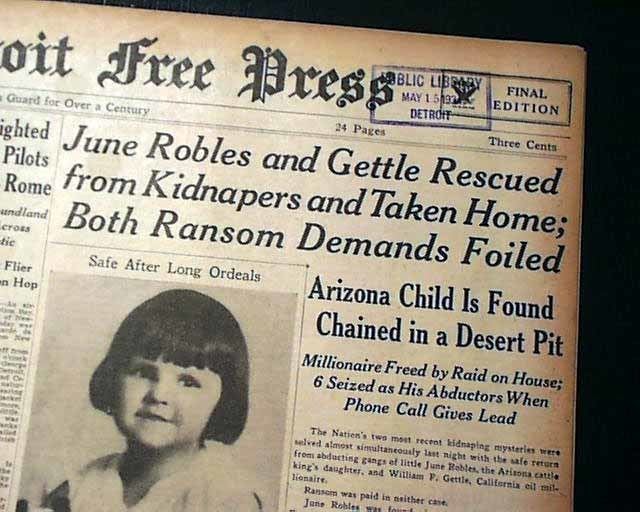Name June Robles | ||
 | ||
June robles tells own kidnap tale aka june noble tells how she was kidnapped 1920 1929
June Robles (born c. 1928) was a notable kidnapping victim from Tucson, Arizona. She was the daughter of Fernando Robles, owner of the Robles Electric Company. Her grandfather, Bernabe Robles, was one of Tucson's wealthiest citizens. Her mother was Helen Robles, and she had one other sister who was not named in press reports. She was also the niece of Carlos Robles who, at the time of her abduction, was the Assistant County Attorney for Pima County, Arizona.
Contents
- June robles tells own kidnap tale aka june noble tells how she was kidnapped 1920 1929
- A story 80 years in the making what happened to june robles
- Disappearance
- Ransom
- Recovery
- Aftermath
- References
A story 80 years in the making what happened to june robles
Disappearance
Six-year-old June was taken by an unidentified man on April 25, 1934 at 3:00 pm. The man was described by witnesses as wearing glasses and as dirty and emaciated. She unwillingly entered the stranger's Ford Sedan outside Roskruge School. Witness Marguerite Smith saw the event as she was picking up her son from the school, but assumed it was a family matter and decided not to interfere. June was on her way to the home of her aunt, Mrs. Herman F. Kalenga, when she left the school.
Ransom
At about 5:00 pm that same day, Fernando Robles was handed a note by a child, Rosalio "Goyo" Estrada. The boy had been paid 25 cents by a member of the kidnapping party to deliver the message, which demanded $15,000 for June's safe return. June's father began communicating with his daughter's captor, who identified himself as "Z" in the correspondence. Robles did not immediately go to the police, and it is likely that he would have attempted to negotiate with the culprit, or culprits, on his own.
Very soon, local law enforcement did become involved with the case, setting up blockades around the city and scouring the area for clues. The case attracted a great amount of media attention and the press dubbed it "the greatest manhunt ever staged in the West." Clyde Barrow was reported as a suspect early in the investigation. The second ransom note reduced the ransom to $10,000 and instructed Robles where to deliver the money. Robles attempted to deliver the money on a specified strip of highway, but no recipients emerged. On April 28, two men in a brown Chevrolet robbed a cafe near Fort Huachuca. In their company was a child said to resemble June Robles. Her father's twin brother, Carlos, very publicly commandeered an airplane in his effort to search for his niece.
On May 7, chief criminal deputy Oliver White announced that June had been found and would be returned to her parents within twenty-four hours. This followed the supposed sighting of June in the company of a couple headed for the US/Mexican border and White's subsequent trip to Sonora, Mexico. The announcement turned out to be premature; June was still absent the next day.
Recovery
On May 14, after much searching and scant communication from the abductors, Arizona governor B.B. Moeur received a postcard at his office describing June Robles' location in the desert outside Tucson. The postcard bore a Chicago postmark. A team that included Carlos Robles, Pima County Attorney Clarence Houston, and several Highway Patrolmen searched the area for two hours before discovering a small metal box, sunk three feet into the ground and disguised with some shrubbery. June was inside, alive and in surprisingly good health. She had been chained in the iron box in the desert for 19 days. Interestingly, another high-profile kidnapped person was recovered that day: William F. Gettle, an oil millionaire from Beverly Hills who had been missing since May 9, was found in the Los Angeles home of his kidnapper.
Who exactly was responsible for the abduction of June Robles has not been positively established. Two suspects were brought in for questioning and shown to June, but she was unable to positively identify either of them. A dance hall proprietor named Oscar 'Buster' Robson was initially charged because of similarities between his handwriting and the "Z" ransom notes. The charges were eventually dismissed. There were allegations that the kidnapping had been an inside job masterminded by a disgruntled relative in Mexico, or by an immediate member of the Robles family, but no evidence could be found to support either of these theories.
Aftermath
June Robles retreated from the media spotlight at the behest of her parents, though Fernando Robles did at one point announce that he had accepted an offer to exhibit his daughter in a vaudeville show. Bryan Foy and Sid Grauman both approached Robles, hoping to sign June for personal appearances.
A year and five days after the recovery of June Robles, an unnamed dying man came forward with more evidence, implicating three people, and J. Edgar Hoover announced that the case had been solved. The deathbed confession did not result in any further convictions.
A play, June In A Box by Octavio Solis, was based on the Robles kidnapping. It premiered at Intersection for the Arts in San Francisco on March 6, 2008.
